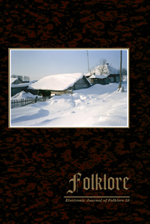Seto Singing Tradition in Siberia: Songs and ‘Non-Songs’
Seto Singing Tradition in Siberia: Songs and ‘Non-Songs’
Author(s): Janika Oras, Andreas KalkunSubject(s): Customs / Folklore
Published by: Eesti Kirjandusmuuseum
Keywords: diaspora; identity; Russian song; Seto song; Siberia; singing tradition; women’s choirs
Summary/Abstract: The article is based on fieldwork carried out in the 2000s among diasporic Setos living in Krasnoyarsk Krai, Russia, and discusses issues related to the singing tradition and identity of the Setos in this area. The article explores the ambivalent attitudes of the local singers towards their singing tradition and proposes a systematisation of the song tradition in the area into three groups – Estonian songs, Russian songs, and Seto songs. The latter of the three represents the most archaic part of the Seto tradition, even though singers today no longer regard this part of the tradition as ‘proper’ songs, because of their improvisational and spontaneous nature. In addition to the ambivalence and confusion related to the identity and singing tradition, one can see conscious efforts in shaping identity politics and representing culture in Seto villages in Siberia. The best example of this is the Seto Museum and the choir active in Khaidak village. The generation of singers who are members of the choir today have discovered the old tradition in advanced age, but nevertheless find the singing of traditional songs highly significant. An important part of the contemporary identity politics of this tiny diasporic group is performing their exotic singing culture.
Journal: Folklore: Electronic Journal of Folklore
- Issue Year: 2014
- Issue No: 58
- Page Range: 149-186
- Page Count: 38
- Language: English

